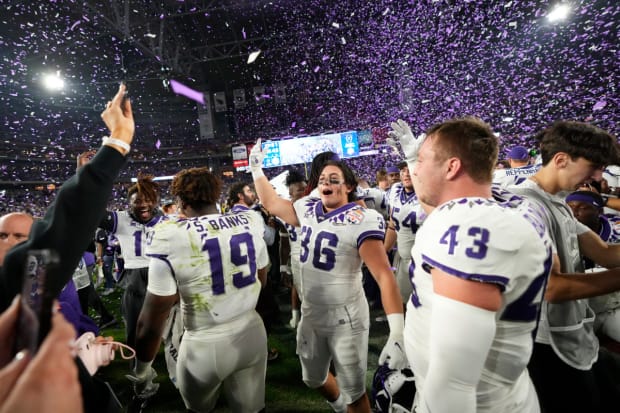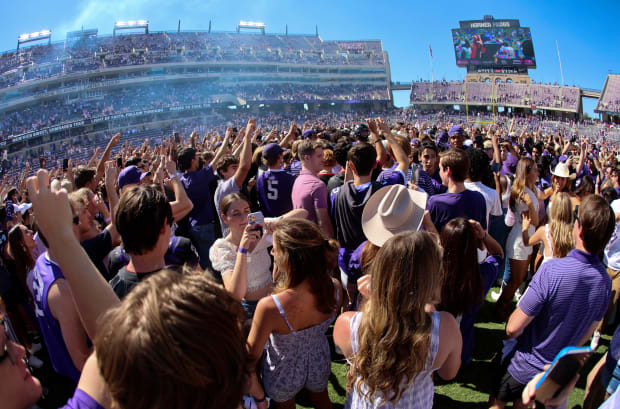LOS ANGELES—Did Kirk Herbstreit misspeak? If you watch a replay of the 2011 Rose Bowl—which until this past Dec. 31 might have been the biggest victory in TCU history—ESPN’s college football analyst mentions the positive momentum the Horned Frogs could carry from beating Wisconsin into their new conference, the Big East.
Check the record books and you won’t find any evidence of TCU ever playing in the Big East. But Herbstreit was right.
For 10 months, the Frogs were ticketed to join that league—their fifth in a 16-year span, following the Mountain West, Conference USA, the Western Athletic and the Southwest. They were a geographic outlier latching onto a consortium from the Eastern Time Zone, a vagabond school wandering the country in search of a place to play big-time football. But before that forced marriage with the Big East was consummated, the golden ticket to join the Big 12 arrived.
Today, on the cusp of TCU (13–1) playing Georgia (14–0) in the College Football Playoff national championship game Monday, it all seems surreal. The Frogs are the lynchpin member of a Power 5 league that shunned them in the 1990s, forcing their sojourn. First-year Big 12 commissioner Brett Yormark was making the rounds at Saturday’s media day, basking in the glow of the conference’s first CFP title-game appearance, and it was not lost on some observers how little the league wanted to do with TCU less than 30 years ago.
“Nobody likes to not be invited,” TCU faculty representative Joe Helmick told the Fort Worth Star-Telegram on Feb. 25, 1994, the day the Southwest Conference’s demise was finalized and membership was set in what would be the Big 12. The members of the Big Eight (Colorado, Iowa State, Kansas, Kansas State, Missouri, Nebraska, Oklahoma and Oklahoma State) added four teams from the SWC (Baylor, Texas, Texas A&M and Texas Tech). Four others were kicked to the curb (Houston, Rice, SMU and TCU).

Ross D. Franklin/AP
After spending nearly all of the 1960s, ’70s, ’80s and early ’90s as a punching bag for much of the rest of the Lone Star State, TCU was off on its multi-conference odyssey.
TCU became part of the 16-team morass that was the WAC in 1996, with coach Pat Sullivan resigning the next season during what was a 1-10 disaster. Fan apathy was deep enough at that time that TCU student Cody Reynolds remembers being able to stretch out in the student section, his feet on the row of bleachers in front of him and his back reclining on the row behind, with no one around.
“My buddies used to stay in the dorm on game days and watch Big Ten games on TV,” says Reynolds, who went 13 straight years without missing a home game and attends at least one road game per year.
Sullivan’s one significant contribution on the way out: recruiting a running back from Rosebud, Texas, named LaDanian Tomlinson. Sullivan was succeeded by Dennis Franchione, who put Tomlinson to work and turned the program around. By 2000, Tomlinson’s senior season, the Frogs were 10-2 and WAC champions, but that didn’t get them anything better than a Mobile Bowl bid and a game against Southern Mississippi.
When Franchione left after that season for Alabama, some TCU players advocated for offensive coordinator Mike Schultz to replace him, but athletic director Eric Hyman opted for the defensive coordinator, Gary Patterson. It would prove to be a momentous choice.
With a new coach, TCU entered a new league, C-USA, which was not necessarily a voluntary move. The 16-team WAC proved to be an unwieldy creation, so eight schools broke away to form the Mountain West. TCU, located in the Central Time Zone while the other members were in the Pacific or Mountain, was once again uninvited. After going 6–6 the first season in C-USA, Patterson established his credentials in ’02 by going 10–2 and beating Colorado State in the Liberty Bowl. It was the first of 11 seasons of double-digit victories under Patterson, who became the greatest coach in school history and today has a statue of himself outside Amon G. Carter Stadium.
“We started to figure out pretty quickly that, when it came to coaching, GP was smarter than your guy,” Reynolds says.
Patterson’s early success helped TCU get into the Mountain West in 2005, as the league wisely recognized the value of having a presence in Texas. Meanwhile, starting under Hyman and continuing under his successors as AD, the school embarked on an ambitious series of athletic upgrades.
“Everyone knows about the financial commitment, but I’m talking about an emotional one,” says Brian Estridge, the radio voice of TCU football since the late 1990s. “These folks love the place. They were willing to do whatever it took—I’m not just talking about finances, I’m talking about using connections. It’s deeply rooted. They’re not a flash in the pan. It has transpired over a long period of time. They really watered it deep.”
New facilities were built. Old facilities were upgraded (including a jaw-dropping makeover of Amon G. Carter Stadium.) Staff was added. The city of Fort Worth was aggressively recruited to partner with the school in building the fan base—with a small enrollment and correspondingly small alumni base, there was a need for “T-shirt fans,” as Estridge puts it. Sitting on top of a talent gold mine in the Dallas-Fort Worth Metroplex, it all started to come together.

Kevin Jairaj/USA TODAY Sports
Boise State got a lot of attention as the Power 5 outsider darling, but a case can be made that TCU was better. While winning the Mountain West three straight seasons from 2009-’11, the Frogs went 36-3 and won that Rose Bowl. It was during that time the school agreed to join the Big East, which would have been a tough fit, but fate intervened on their behalf. The Big 12 started to fracture—Nebraska jumped to the Big Ten, Colorado to the Pac-12, Missouri and Texas A&M to the SEC. Looking for new stability, the league saw a school in its backyard that had positioned itself for Power 5 membership.
“They were desperate to get back to the Big 12,” Estridge says. “They felt shunned, they felt slighted, but it was probably the best thing that could have happened. It was a wakeup call. Hyman came in and had to rebuild the infrastructure, as he called it, because it was so bad. Once he got that built, you had a foundation and he could go on from there.
“It was also being opportunistic and not being afraid to change. These guys were willing to take risks. You always hear, dress for the job you want, not the one you got. TCU has always done that—they always dressed for the job they want, and treated athletics like they were in the Big 12, even when they weren’t in the Big 12. They knew what they wanted to be and never lost sight of that North Star. The Big 12 was the North Star.”
There was a two-year adjustment to the competition level, and then TCU resumed winning big again. The Frogs went 12–1 in 2014 but were snubbed by the first College Football Playoff selection committee, dropping from No. 3 to No. 5 after winning their final game by 52 points. The team that took its place in the bracket: Ohio State, which went on to win it all.
“I hate Ohio State,” Reynolds says. “They took our national championship. I’ll never forgive them for that.”
But the team Reynolds and most TCU fans hate most is Texas. The Longhorns were part of the move that broke up the Southwest Conference and have been seen as a high-maintenance Big 12 colleague. Now, Texas and Oklahoma are headed to the Southeastern Conference, which destabilized the Big 12 and brought some old fears back to the surface for TCU.
“Owning UT has been job one,” Reynolds says of TCU’s 7–2 record against Texas since 2014. “Texas and OU tried to ruin it, so it’s been nice to see those two limp out of the conference.”
Meanwhile, the Horned Frogs strut forward as the current flagship program of Texas football. That’s still taking some getting used to within the Lone Star State, where TCU had 31 losing seasons between 1960–’97. The slow build toward full respect rankles more than a few folks at TCU.
“Sometimes, in the past, you felt like you were a bigger name or more respected outside of Texas,” says Mark Cohen, TCU’s associate athletic director for strategic and football communications, now in his 18th year at the school. “I think that’s starting to change now. I think this Playoff appearance has changed our program forever.”
TCU’s past has created a Cinderella-type storyline around this team—the “UnderFrogs”—but the present shows a program with plenty of muscle.
“It’s a different place,” Cohen says. “Even when we won the Rose Bowl, we were kind of that cute little underdog, the little school that could. We don’t view ourselves that way anymore. We’re a legit Power 5 institution. Look at our resources, our commitment, the recruiting that we do. People who set foot on our campus that haven’t been there before, they’re blown away. People want to be here now. We’ve got dudes here.”
In addition to the dudes on the field, there will be a lot of purple in the SoFi Stadium stands Monday. For a small school, the turnout is big. No one connected with TCU wants to miss this, especially those who remember wandering the multi-conference wilderness for years on end.
“We’ve checked a lot of boxes,” Reynolds says. “We’ve got one left to check.”







